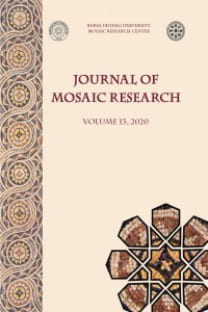A Roman Mosaic Unearthed in Armazéns Sommer (Lisbon). Archaeology and Iconography
Lizbon kentinde, Rua Cais de Santarém'de, 40-64 numaralı parseller arasında, kuzeyde Rua de São João da Praça ve doğuda Travessa de São João da Praça ile sınırlanan alanda, Sommer olarak bilinen eski ve oldukça geniş bir deponun temelleri üzerine inşa edilmesi planlanan Cais de Santarém isimli yeni bir otel çalışmaları esnasında, Demir Çağı'ndan başlayarak 20. yüzyılın ilk yarısına kadar uzanan geniş bir zaman dilimini kapsayan ve Lizbon kentinin zaman içerisindeki gelişimini benzersiz bir şekilde gözler önüne seren arkeolojik tabakalanma tespit edilmiştir. Roma kent konseptine ilişkin olarak iyi korunmuş odalara, boyalı duvar plasterlerine ve mozaik döşemesine sahip bir domus tespit edilmiştir. Bu çalışmada, söz konusu yapı tanıtılacak olup, kazı çalışmaları, tabakalanma, mimari ve ikonografik özellikler tartışılacaktır
Armazéns Sommer’de (Lizbon) Açığa Çıkarılan Roma Mozaiği. Arkeoloji ve İkonografi
Aiming the construction of a new hotel (Hotel Cais de Santarém) using the previous basement of the large storage known as Sommer, located in Rua Cais de Santarém, nºs 40 up to 64, and limited by Rua de São João da Praça northwards and by Travessa de São João da Praça eastwards, in the city of Lisbon, a large amount of archaeological contexts were uncovered that uniquely illustrate the stratification of the city of Lisbon between the Iron Age and the first half of the 20th century. Concerning Roman urban contexts was found a domus with rooms well preserved with painted walls plaster and a pavement covered with mosaic. In this paper the authors will present the monument and further discussions will take place on excavation levels, iconographic and architectural features
___
- Amaro – Caetano 1993-1994 C. Amaro – M.T. Caetano, Breve Nota sobre o Complexo Fabril Romano da Rua Augusta (Lisboa). Conimbriga, XXXII-XXXIII, 283-294.
- Basarrate et al. 2002 T. N. Basarrate – A. Carvalho – M. J. Almeida, “El Programa Decorativo de la Quinta das Longas (Elvas, Portugal): un Modelo excepcional de las Villae de la Lusitania”, M. N. Romano (ed.) Actas de la IV Reunion sobre Escultura Romana en Hispania, 103-156.
- Caetano 2001 M. T. Caetano, Mosaicos Romanos de Lisboa - A Baixa Pombalina, Conimbriga XL, 65-82.
- Gaspar – Gomes 2007 A. Gaspar – A. Gomes, “As Muralhas de Olisipo: troço junto ao Tejo” Em A. Rodríguez Colmenero - Rodá de Llanza, Murallas de ciudades romanas en el occidente del Imperio: Lucus Augusti como paradigma, 685-698.
- Gomes 2004 A. Gomes, Armazéns Sommer - Relatório das Escavações Arqueológicas, Lisboa.
- Gomes 2005 A. Gomes, Armazéns Sommer, Relatório das Escavações Arqueológicas, Lisboa.
- Manas Romero 2009 I. Manas Romero, Pavimentos decorativos de Itálica. Una fuente para el estudio del desarrollo urbano de la ampliación Adrianea, ROMVLA 8, 179-198.
- Rosenzweig 2004 R. Rosenzweig, Worshipping Aphrodite: art and cult in classical Athens, Michigan, University of Michigan Press.
- San Nicolás Pedraz 1994 M. P. San Nicolás Pedraz, “La iconografia de Venus en los mosaicos hispanos”, Em C. d. Junta de Castilla y León (ed.), VI Colóquio internacional sobre mosaico antiguo, 393-406.
- ISSN: 1309-047X
- Başlangıç: 2008
- Yayıncı: Ululdağ Üniversitesi, Mozaik Araştırlmaları Merkezi
Sayıdaki Diğer Makaleler
Mosaic Programmes in Domestic Contexts at Zeugma
The Geometric Themes in the Mosaics of the Religious Complex of Mértola (Portugal)
Virgílio António Martins LOPES
RoGeMoPorTur: Roma Mozaikleri Üzerine Portekiz-Türkiye İşbirliğinde Bir Proje
Urbs in Rure: Decorative Programmes and Architectural Models in Lusitania’s Villae
The Mosaics of the Roman Villa of São Simão, Penela, Portugal
A Roman Mosaic Unearthed in Armazéns Sommer (Lisbon). Archaeology and Iconography
Ricardo Ávila RIBEIRO, Vasco Noronha VIEIRA, Paulo REBELO, Nuno NETO
